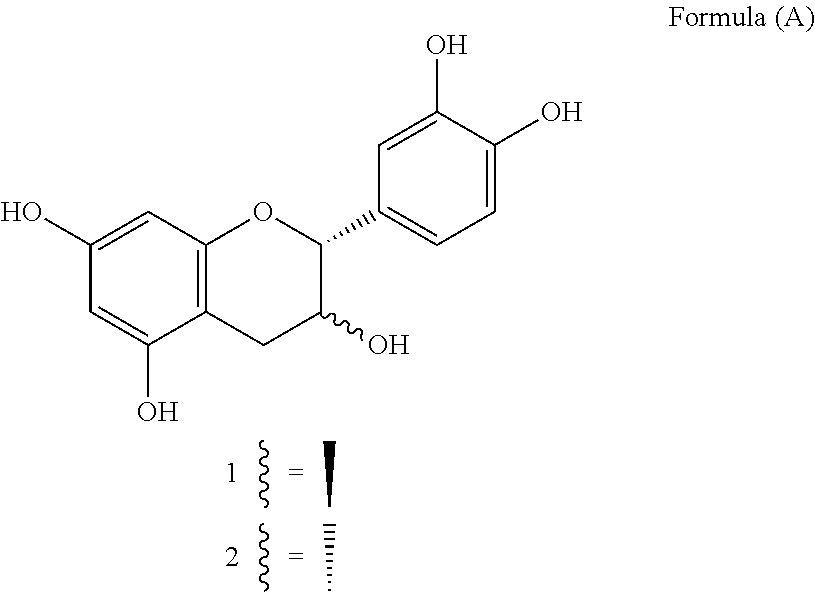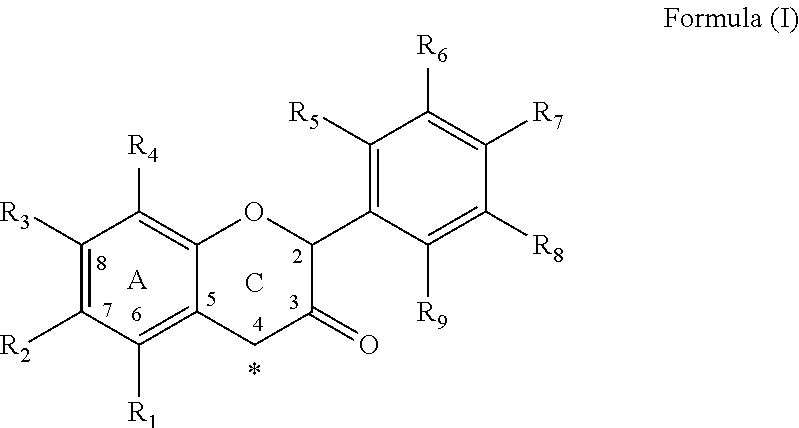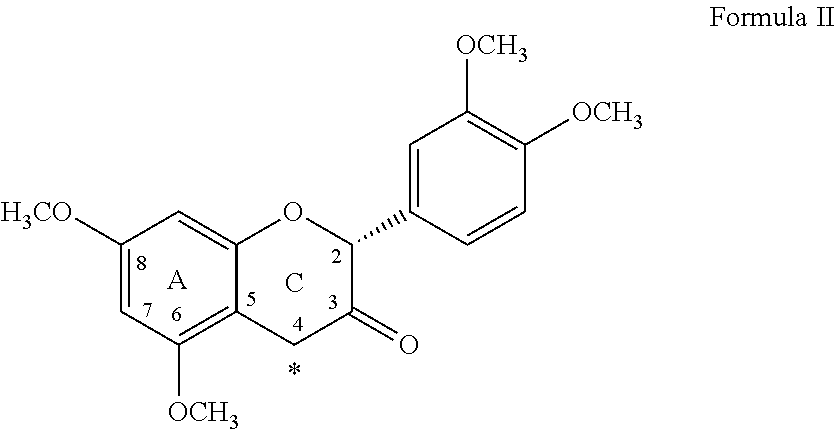Method for the Preparation of C-4 Coupled Flavonoids, Proanthocyanidins and Analogues Thereof
a technology of proanthocyanidins and coupled flavonoids, which is applied in the field of process for the preparation of c4 coupled flavonoids, proanthocyanidins and analogues thereof, can solve the problems of undesirable self-condensation of c-4-functionalized precursors, hampered above methods, and slow progress in the chemistry and biology of these compounds, and achieves enhanced electrophilicity
- Summary
- Abstract
- Description
- Claims
- Application Information
AI Technical Summary
Benefits of technology
Problems solved by technology
Method used
Image
Examples
example 1
[0073]A 3-oxo-derivative of flavan-3-ol (compound 4) was prepared from flavan-3-ol as shown in Scheme 1 below.
[0074]Referring to Scheme 1, flavan-3-ol, more particularly 5,7,3′,4′-Tetra-O-methylcatechin (compound 3), was prepared as follows:
[0075]Dried (+)-catechin (10 g, 35 mmol) was dissolved in dry acetone (250 mL) under an inert atmosphere (N2). K2CO3 (38 g, 276 mmol) was added and suspended in the reaction mixture. After stirring for 1 hour, dimethylsulfate (87 mg, 276 mmol) was slowly added over a period of 30 min. and the reaction mixture refluxed for 2 hours. The K2CO3 was filtered off, the acetone removed under reduced pressure and the excess (CH3)2SO4 destroyed with cold ammonia (80 mL, 25% NH3 / H2O, v / v). The reaction mixture was subsequently extracted with ethyl acetate (2×100 mL), washed with water (2×70 mL) and brine (70 mL), dried over MgSO4 and the solvent removed under reduced pressure. The compound 3 was obtained as an off-white, amorphous solid (11.9 g, 99%).
[0076]...
example 2
[0094]In the embodiment of the invention wherein the nucleophilic aromatic moiety of the compound is a flavanyl moeity, the flavanol species, in the form of favan-3-ol, was contacted with the 3-oxo-derivative to form a proanthocyanidin adduct. More particularly, compound 3 and compound 4 of scheme 1, prepared in the manner herein described, were contacted with each other in the presence of AgBF4 in THF as a solvent to produce (2R,4S:2R,3S)-5,7,3′4′-tetra-O-methylflavan-3-one-[4→8]-5,7,3′,4′-tetra-O-methyl-flavan-3-ol (compound 18) and (2R,4R:2R,3S)-5,7,3′4′-tetra-O-methylflavan-3-one-(4→8′-5,7,3′,4′-tetra-O-methylflavan-3-ol (compound 19), respectively. This is shown in Scheme 4 below.
[0095]With reference to Scheme 1 and Scheme 4 compounds 18 and 19 were prepared as follows:
[0096]Under a N2 atmosphere compound 4 (50 mg, 0.145 mmol) and AgBF4 (215 mg, 1.1 mmol) were dissolved in THF (3 mL). A solution of compound 3 (150 mg, 0.435 mmol) in THF (3 mL) was added dropwise and the reactio...
PUM
| Property | Measurement | Unit |
|---|---|---|
| v/v | aaaaa | aaaaa |
| structure | aaaaa | aaaaa |
| antioxidant | aaaaa | aaaaa |
Abstract
Description
Claims
Application Information
 Login to View More
Login to View More - R&D
- Intellectual Property
- Life Sciences
- Materials
- Tech Scout
- Unparalleled Data Quality
- Higher Quality Content
- 60% Fewer Hallucinations
Browse by: Latest US Patents, China's latest patents, Technical Efficacy Thesaurus, Application Domain, Technology Topic, Popular Technical Reports.
© 2025 PatSnap. All rights reserved.Legal|Privacy policy|Modern Slavery Act Transparency Statement|Sitemap|About US| Contact US: help@patsnap.com



